Our friendly representatives will gladly answer any questions you have about your event marketing project.
By H. Glenn Godfrey, CEO, Eyekon Group, LLC
During all the years I worked trade shows, there was always one or two exhibitors whose message was seared into my mind, and the message traveled back home with me, forcing me to follow up for more information or to purchase. These were the disruptive companies who stood out from the crowd. This is the kind of company we want to send to a trade show as our client. Being disruptive doesn’t mean breaking the rules; often it just means breaking tradition. Even the most traditional company wants to be remembered; to be branded as cutting edge, to break the mold. You can’t achieve this by being visually and graphically conservative. You’ve got to be disruptive. We want our exhibitors to break the mold; to be the company that travels home in the mind of the trade show attendee.
No matter if you’re an Eco-activist or an Economical manager, or both, fabric architecture makes earth-friendly sense, but more so, fabric architecture makes economic sense. Fabric Architecture is the fabrication process of forming a metal skeleton in the shape of a product, animal or wall and wrapping it in a skin of printed fabric graphics.
Fabric display construction has become a dominant influence in recent years for a number of reasons. Chief among them is tighter budgets and the requirement for more economic efficiency. Aluminum framing and fabric skin means lighter weight, which translates into less shipping costs, faster setup, faster dismantling, and more compact storage requirements to provide a more efficient exhibit marketing process. Graphics printed on fabric can be bigger, brighter and bolder. Graphics can be changed easily and inexpensively to fit the theme of a show. Increasingly, smart CEO’s are realizing the benefits of fabric construction. Fabric doesn’t use a lot of resources, is recyclable and fabric graphics leave a small, earth-friendly footprint.
Fabric works well for portable displays and is a perfect medium for larger custom trade show and event exhibits. Fabric architecture and fabric graphics save at every stage of your project, including construction, set up, dismantle and storage. Most importantly, fabric graphics provide big, bold, larger-than-life images. When a fabric graphic skin is stretched over a lightweight aluminum frame, the result is a very compact, lightweight package for economy in shipping and setup. We can bend the skeleton design to nearly any shape to convey your product or theme and the fabric skin takes on the shape of the design.
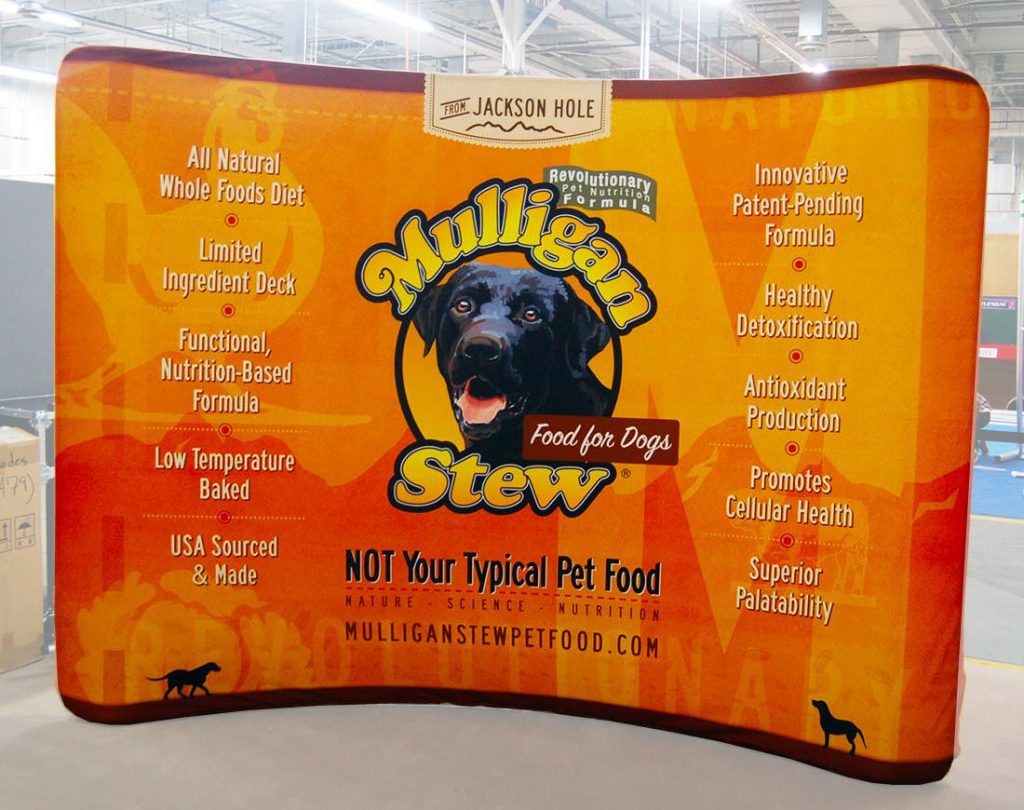
Portable Displays become more portable as illustrated by this tensioned fabric over a lightweight tube frame.

Fabric display construction has become a dominant influence in recent years. This fabrication process facilities shapes not previously practical.

Fabric graphics can be big and bold, while saving money at every stage, and, fabric architecture leaves a very small, eco-friendly footprint.

Fabric Architecture makes large structures more affordable to construct while saving on shipping and setup costs. Note the giant red modular fabric exhibit with the 10-ft portable display positioned outside the larger exhibit for additional messaging.
The retractable banner stand is a simple, efficient solution to portability and message delivery. The retractable banner stand should not be confused with a “fixed” banner holder. The fixed, non-retractable version is not as versatile, is more prone to damage and requires a larger floor footprint.
Retractable Banner stands are effective enough to serve as your major display or can be carried along as a “plan B” backup to your larger display in case there is a logistical snafu and your “A-game” display is delayed or lost. Peace of mind can be priceless. The retractable banner stand can function as a free-standing graphic promo sign or as a component to a larger display by using multiple stands to form a larger background graphic to your exhibit space, in effect, becoming your display. In this configuration, the banner stands can form the simple back wall for a 10 or 20-foot display. The Key to an effective retractable banner stand “back wall” is to avoid your background looking like 3 or 4 different banner stands, so, do not try to combine banner stands containing non-congruous messages. The impression you present will not be good. Do design your graphic as a single image graphic as if it were one large print using the same message principles as described under “Developing Your Message” (more on this below).
Retractable banners can serve as lobby displays, company information space within the facility, and event support between trade shows.
Note: Retractable banner stands come in various levels of quality. Refer to our Eyekon Presentation Products section for our recommendations for best quality and best economy.
The higher quality retractable will provide longer service, a more substantial image for your brand, and more convenience in the form of interchangeable graphic image cartridges. The cheapest one may not make it to the first application as it could lose tension, become droopy, curl and generally give a bad impression of your product and company.

Two or more retractable banners make a simple back wall for your show or event. Plan graphic as if it will not be broken into sections so the break between banners will not be a distraction.

Retractable Banners can reduce your event setup time if used behind a frame system such as our OutRigger Shelf system. (See Shelf Display accessories in our Eyekon Display products section). The graphics are protected by its self-contained base.
The Pop-up display is a more complex structure but is still simple to set up and is a more substantial platform than a banner stand. While remaining light and portable, the pop-up can accommodate more sophisticated lighting options, both external and internal. Shelving and a moderate amount of hardware such as digital video signage, and lightweight hangers for products such as clothing and apparel are also options.
The basic pop-up features roll-up polycarb or fold-up fabric graphic panels for compact transport and simple setup.
A recent trend using compact lighting is the internally lit pop-up for high impact message delivery. The big, bright “light box” can’t be ignored. However, this “pillowcase” fabric graphic application limits the shelving and hanging hardware that can be used on the pop-up frame.
Pop-up frames have been around for some years, but the advent of fabric skin has added new versatility and economy to pop-ups. Custom dimensioned pop-ups make custom portables a practical option for modular construction.
Note: The Montage pop-up variation offers a simpler platform, which is extremely versatile in that smaller fabric graphic panel sections can be changed out between events to customize your message to fit the theme of the event, without changing the entire fabric graphic. (See our Eyekon Display Products section)
The backlit pop-up and the Montage pop-up take advantage of the fabric graphic for increased portability, versatility and economy.

The Pop-up has been a versatile option for several years and can be produced with a customized look as above, sans the custom price. They provide modest savings in shipping and storage.
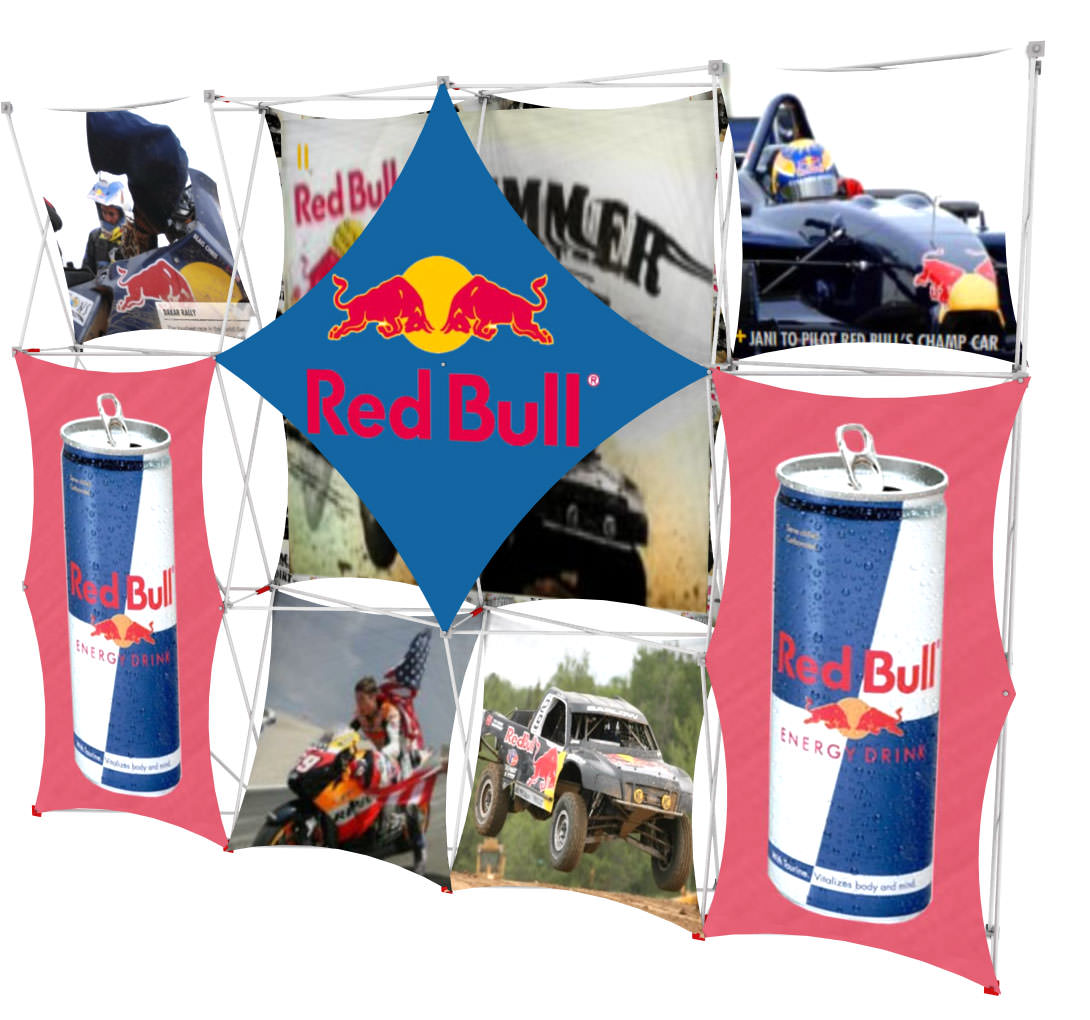
The Montage pop-up display offers the most versatility among pop-up displays because the stretch fabric panels can be more easily updated for each event without changing the entire graphic. Internal shelving and dramatic internal lighting can be added.
A more recent option for portables is the round tube aluminum frame used as a skeleton for pillowcase fabric graphics. Most of the tube frames are even lighter than a pop-up with fewer parts to assemble but again provide fewer showcase options.
Note: A popular solution to shelving is our OutRigger, snap up frame system used as a portable adjunct to portable displays as well as custom displays. (See our Eyekon Display Products section)

While Tensioned fabric tube frame systems offer little product or video mounting access, any display can add our Eyekon OutRigger video/workstations to provide support video signage, light boxes, or product shelving. See our Eyekon Presentation Products section. The unit shown above illustrates the Eyekon OutRigger kiosks for mounting video displays.

Tube Frame Systems offer a lot of graphic communication area for a modest price. Tension Tube Frame displays depend on tensioned fabric “pillowcased” over the frame. It is a very simple, easy assembly system.

Tube Frame displays collapse down to a very compact, easy transport package but offer minimal shelf and product support accessories, however, Eyekon Display OutRigger shelving systems can be added to any tensioned Fabric system. Many displays require a very tight, snug fit to hold the strength and shape of the unit, as shown above.
Portable and modular systems have become so customizable that they can be used as adjunct elements to blend into a larger display structure. This is an important consideration when you want your display to grow with you, thereby minimizing your long term investment for trade show marketing. As indicated above, fabric graphics lend themselves to small and large frame structures. Even fully custom displays can be constructed for compact shipping and added cost-savings.
Portable displays can be combined to meet your need for a large event. A large custom look can be created by using smaller portable components to create a custom hybrid. The advantage is that the display can be used for your largest events and then broken down for smaller events. You can also adopt this tactic using rental displays. As your company grows, you can use your existing display, and purchase or rent new portable elements to complement the existing display you previously purchased. This assumes you purchase or rent a portable compatible in appearance to your previous one. This is something to keep in mind when planning future growth. Note: The Eyekon Group can provide the portable or custom display additions to give you display space a new look. The things that make our portables different are the custom options you can add to create a display that exactly fits your needs.
Hybrid displays generally combine the ease of setup, shipping and storage with the economy of a portable. You can rent or purchase an Eyekon hybrid display as a standalone or to expand and add to your existing display property.
Our Design Team can combine portable display systems with our custom designed elements to provide a totally custom look that gives you a distinctive presence and saves you money.

Hybrid pop-up displays, banner stand back walls and portable forum showcases create this custom look. (see our Eyekon Display products section on this site or call an associate at Eyekon Group for a custom quote.)
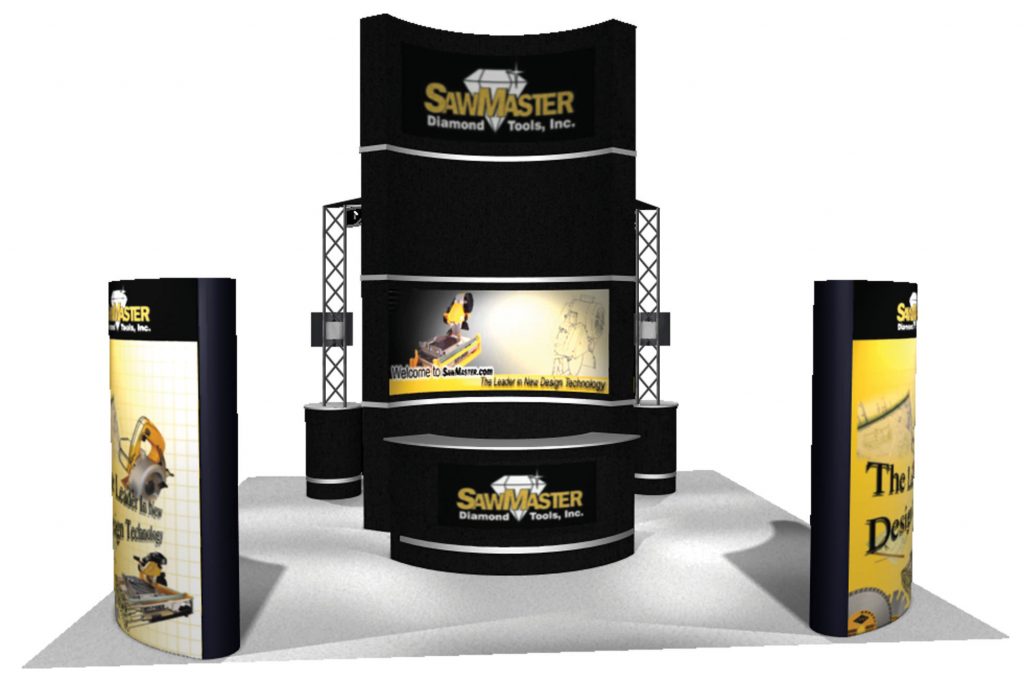
A portable display shouldn’t look like one. Portable elements can become the focus component of your exhibit or can provide support graphics as separate elements.

Portable Displays can serve as displays for smaller events and adjuncts to your larger display format.

Portable Profile Extrusion and banner stands turn standard display components into a 20-foot inline custom display. The display’s shipping containers, above and below, convert to pedestal counters.
Custom Exhibits provide the opportunity to totally infuse your brand in the manner you choose, unhampered by the constraints of an existing, off-the-shelf display structure. Imagination can run wild and is limited only by the creative talent and skill of your exhibit house. Custom exhibits often require a larger, more dominate space; 20 or 30-foot in-line isle space or larger island space, but not always. A small display can dominate a show if it is disruptive in its design, graphics, and message delivery.
Theme exhibits usually require an increased level of design and fabrication, often meaning a custom design is needed, however, a theme can also be created by application of creative graphic panels and fabric skin graphics printed to a modular or portable display. A large printed fabric graphic can be applied to a portable frame system to represent a large architectural environment such as an entrance to a department store, thus, creating the theme of the product’s retail environment. A theme tied to the target market or to your product and service can make your company more memorable long after the show. Eyekon Group can develop your display structure as well as your theme graphics for a portable, modular or custom display using your company images, your vendor images or we will source stock images around which to build your theme graphics.

A totally custom scenic environment can be created using a rental modular frame system. (Contact an Eyekon Group associate to discuss your custom needs.)

Custom Exhibits are limited only by the imagination, creative talent, and craftsmanship of your exhibit house.

The advent of fabric architecture and modular frame profile systems provide the option to rent custom theme displays designed to fit your product or
service.

An innovative, disruptive design can make the most of a small exhibit space and leave a memorable impression on your target market.
Extruded aluminum frame systems have made custom design a more straight forward process and by extension, more affordable. Because the stronger, extruded aluminum frame systems are practically indestructible, the internal support frame for your exhibit can be reused over and over with new face panels or fabric skin. Extruded aluminum frame systems have become more cost-effective and versatile than lumber and laminate. It should be noted that the traditional wood and laminate construction still fills a niche for fully custom exhibit construction. But just as portable displays have advanced beyond the bulky structures of year’s past, modular construction has advanced to become fused with portables.
A major feature of many portables is the no-tools setup factor. For the more sophisticated, extruded aluminum frame systems, a minimum amount of tools and minimum skill may be required.

You don’t outgrow modular frames because they can be purchased and updated year after year or you can rent the frame and focus on your graphic and functional treatments each year. In addition to accommodating multiple surface materials, the system can be internally lighted or wired for video presentations. By applying sound absorbing materials behind fabric graphics, sections of your space can be isolated from much of the background noise.

Designing with Modular Frame extrusion doesn’t have to sacrifice dramatic impact as illustrated by this traffic-stopping exhibit.

Lightweight extruded profile has made sophisticated custom construction a cost effective alternative to traditional wood and laminate casework. This construction is eco-friendly by virtue of its’ use of recyclable and reusable materials.

The extrusion shown here (B62) can accommodate internal wiring and a variety of materials including rigid face panels and fabric graphic skins.

Truss space beams provide an industrial look for custom applications. Truss comes in various weights and strength. Most truss is engineered and built to be load bearing. As a load bearing structure, truss can support heavier video monitors, speakers, ceiling panels, lighting and extensive graphics. Truss can form a support bridge to rise above the crowd while supporting down lighting and suspending products or giant video panels to attract attention from across the exhibit venue.
Considering its custom design versatility, truss is a very good rental option because fabric graphics, light box panels, special effects projectors, and hardware can be mounted at minimal expense compared to custom built structures using traditional construction materials such as wood and laminates.
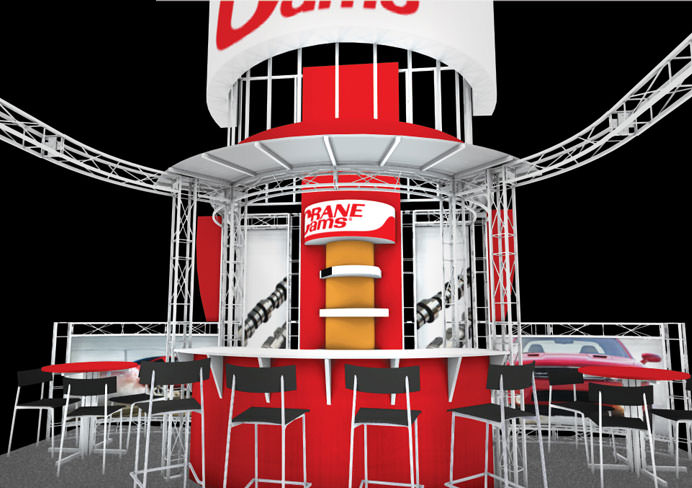

A Truss Space beam is a medium that simplifies design while giving an industrial look. It can simplify component mounting and provide a load-bearing function as above. While not normally used for smaller space displays, it can provide an industrial, cosmetic look and provide support for larger video, shelf or product mounting, as shown below.

Lighting Can Make or Break Your Exhibit
No matter how bold and innovative your product, and no matter how bright and bold are your graphics, if they are recessed in the shadows and overpowered by the lights of other exhibits, your message will be lost and your investment wasted.
LED lighting has become more pervasive and has nearly replaced the older, hot burning element lamps and spots. LED is lighter, more rugged, uses less energy and is more dynamic for more dramatic lighting effects. LED lights can easily be controlled for color changes, wall washing, and animation. Because they are cooler operating, they are considerably safer.
LED lights combined with fabric architecture, have opened new possibilities for bright, can’t-be-ignored display structures; externally lit as well as internally lit.

Backlighting brings lifelike detail to this environment. LED internal lighting was used in these modular frame walls.

Lights Bring Drama to your Display!

LED Lights facilitate Versatile, creative, and controllable light
applications to displays of every type.

Compact lighting components, primarily compact fluorescents and LEDs give internally lit pop-ups a bright presence that stands out from the crowd.

Lights Get You Noticed!
A video presentation is not only a magnet for your exhibit space but it always delivers a mistake-free pitch that never forgets the important, unique selling points (USP) of your product or service. It always presents your message in the best light and never gets tired. It can be as dramatic as you want and can deliver the mood you want to create. However, a video pitch (or infomercial) can’t replace your booth staff who should follow up and engage your prospect face-to-face to answer questions and gain the personalized information to narrow your sales pitch to fit the prospect’s specific needs.
Generally, a small screen video presentation (14 to 32″) is used to deliver factual information to your prospects after they enter your display space. A larger screen or multiple screens combined into a video wall is used to deliver your message with high-impact drama to move and motivate prospects into your display space. Such presentations not only deliver a bold message, but the impact is remembered and retained longer after the show.
Digital signage and interactive kiosks are gaining favor much the same way social media is making a soft-sell pitch to the market. By creating an interesting, inviting environment, your prospects will be more receptive to your message.
These elements will not replace your event staff but will greatly aid your staff by presenting a consistent, effective and informative sales message.

Grab some eyeballs with motion and compelling content. A video pitch has become more affordable with equipment rental and adds credibility and impact to your message.
A video pitch is most effective if it is an eye-catcher that delivers pertinent information and not just a drone of data delivery. A follow-up verbal message from a booth staffer provides you the opportunity to receive more feedback from the visitors and address their specific needs. Without proper content planning, a video could be what Macbeth called “a tale told by an idiot, full of sound and fury, signifying nothing.” In other words, one can spend a lot of money capturing eyeballs that don’t connect to a brain. You want your sales pitch to be retained by your visitor long after the trip home. Videos should be full of relevant content, signifying useful information.
Video, with its constant motion always attracts attention. It may not be interesting and, thereby, not effective, but, it will always attract attention if it is a major part of your display. The challenge is to make it interesting enough to hold some eyeballs longer than 5 or 10 seconds, because, the thing about a video presentation is that it is fixed and doesn’t vary so it is always the best, mistake-free pitch you can present. The downside is that a video message is fixed and doesn’t vary, so it can’t read the instant feedback from your visitor. On balance, a video presentation is an excellent way to capture eyeballs. Your challenge then is to interact with the visitor immediately after the video viewing or during the viewing if the visitor has questions or loses interest. During the viewing you should act as if this is the first time you have seen the video pitch. This helps the visitor maintain focus and he or she doesn’t feel like you are studying them while they are studying the video. Make the video as large as your space will allow. Bigger is better for an arresting sales pitch and for stopping power.
Take advantage of any relevant sales videos available from your vendors. Combine the video on a separate background screen or side by side with your locally produced video. This method provides a more dynamic, active presentation while adding credibility and gravitas to your local operation. The more professionally produced promotional video reinforces your message and adds substance. However, if both videos are used simultaneously, don’t allow both audios to run at the same time as this would be distracting and undermine both messages. If appropriate to your message, use the audio from your vendor as it will be more professionally produced. The trade show environment is noisy so you may run superimposed text subtitles across the bottom of your video. Usually, it is difficult to ignore information across the bottom of a video.
You can make your locally produced video appear to be a part of your national vendor’s video (with their permission) by positioning the two videos together. Create a video wall or a large panel monitor for the professionally produced video and position a smaller video monitor screen in the middle of the video wall or large screen. The smaller monitor, appearing to be embedded within in the larger screen would present your local message. The center video would be surrounded by a background video that presents one or more vendor videos to support and enhance your locally produced video.
Note: Go-pro and most current HD video cameras have approached the high definition of professionally produced videos so there will be little or no video quality drop-off between your local video and your vendor’s dealer video.
The aspect ratios (relative width/height) should be the same for both video sources. Generally, this can be accommodated with some video editing.

A video wall made of an array of monitors will add big impact to a small space.

Standard video mounts in this design add a custom element to standard portable banner stands being used as background graphics.

If space allows, create a relaxing environment for your video presentation. In this setting, a sales pitch doesn’t feel like a sales pitch, yet, invites your booth staff to interact and gain access to the visitors interests and needs.

A well-produced video can dominate an exhibit, even in a small space.

Combine your supplier’s professionally produced video with your locally produced video to add interest and credibility to your local operation.

Eyekon OutRigger displays make it easy to combine your supplier’s national video with your local video to add impact to your business. Our OutRiggers can also be used anywhere in your exhibit space as freestanding displays.
Bigger than life or smaller than life, video can create an environment that would otherwise not be possible to “immerse” your visitor in the environment.

An interesting video can “take you there,” especially when reinforced by a theme display that immerses the viewer in an environment.

A separate viewing area that is not completely private serves to attract attention yet provides a degree of isolation from the distraction of the rest of the show. (Illustrated above and below).

Trade Shows & experiential events bring you face to face with prospects that have qualified themselves by their presence. If they weren’t interested they wouldn’t be attending the event. In no other environment can you have qualified buyers come to you with a desire to purchase your product. With this face to face encounter, you might accomplish more in a few days than you can the rest of the year. Many companies waste this opportunity as a result of procrastination, lack of planning, and lack of experience. Trade show selling costs much less than field sales call and is more likely to result in a sale. Trade show specialists (such as The Eyekon Group) can fill in the gaps if you lack the time to devote to planning or need trade show management help.
Research the number of attendees and the attendee profile as projected by show management. Set your expectation by estimating the number of face-to-face encounters you think is reasonable. This will help you plan your staffing, based on your booth size. This estimate can be a factor in the delivery of your face-to-face message the time required to deliver your message and how much time you can commit to spending with a visitor. As a starting point, estimate the number of leads you expect to record.
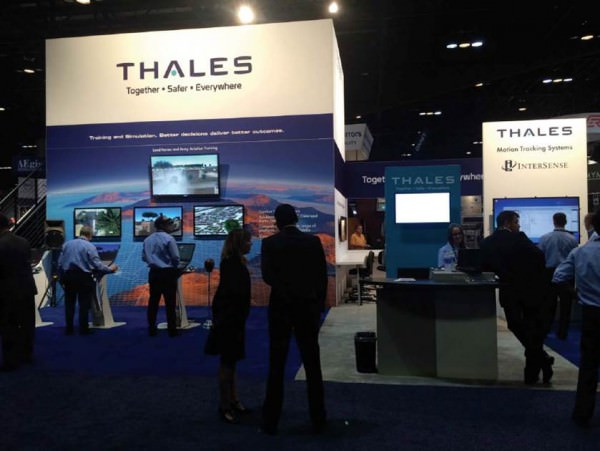
A trade show or experiential event is a good place to gather competitor intelligence and stay abreast of trends, new developments and get marketing ideas.

Face-to-face marketing at Trade Shows and events is considerably less expensive that field sales calls.

Trade Show attendees have pre-qualified themselves as your prime prospects. If they weren’t interested in your product, they wouldn’t have traveled to the show to talk to vendors.
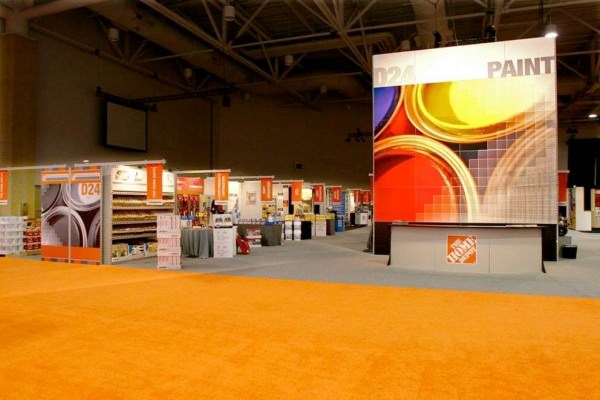
For many companies, trade shows and events are the number one sales expense supporting the sales team.

Your pre-show planning should start with a sequence of steps starting with your strategy and concluding with follow-up calls and sales to show visitors. Each step should have an assigned date for completion.

Your process for collecting leads is an integral part of planning for an event or show.

Introduce new products, introduce new customers and reinforce your brand.

If you have exhibited before, change your image. Fabric graphics can give your display a facelift year to year.
No matter how good your message is, if visitors can’t find you, your message and money is lost. When reserving your exhibit, remember that your location is important. Conventional wisdom says that you want to be located near the center of the exhibit hall so that no matter which way traffic flows, you will be exposed to attendees who start their walk from the left side of the exhibit hall or from the right. But, unlike real estate, your exhibit location is not an overriding factor as most attendees walk the entire exhibit hall. The most important factor is how effective your exhibit is at attracting your target market. But when reserving your space, Avoid:
Continue with Eyekon’s 30-minute information Crash Course seminar and call Eyekon Group to help you develop and execute your trade show marketing plan. If you have developed your plan and just need assistance in developing your message, your display, your graphics, your logistics, and/or show supervision, give Eyekon Group a call.

When reserving your space, there are some sections on the show floor to be avoided.

Location is important, but the overriding factor is your exhibit presentation since most attendees walk the entire show.
Depends on your objectives and budget. Generally if you are testing the water and plan to exhibit only one or two times per year, then renting makes sense. If you are planning more than one exhibit per year and plan to exhibit in years going forward, consider buying.
Note: Avoid a rental from the event or trade show management company. Your image may suffer from lack of imagination, lack of impact, and “failure to communicate.”
The Eyekon Group can provide custom or portable displays for rent or purchase.

Custom Display rentals are flexible in that you can continue a look from show to show or year to year but you can alter the shape and update only the graphics as required without the major investment in a custom built display.

As these two views (above and right) illustrate, a rental doesn’t have to sacrifice design, lighting effects and functionality to be cost effective and effective in selling your brand.
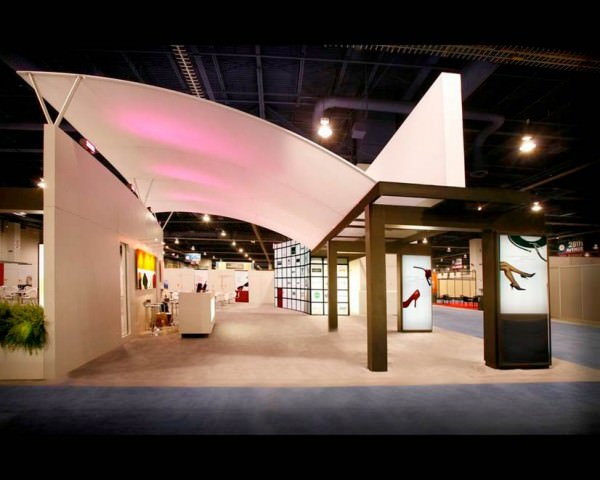
A custom rental can be a cost-effective Strategy.

The Double decker, with an upstairs conference or private VIP presentation area, illustrates the flexibility of a custom rental. The double decker may not be needed for a different show but the basic graphics can be used for a different one-level display without having invested in the upper deck.

Create a news release for your newsletter, for the trade media, for the show guide, for the show attendee email list and direct mail lists. Registered attendee lists are usually available from the show management company. Attendees will plan their booth visits based on the information about the show. Make sure you are at the top of their must-visit list. Your pre-show release should indicate where you are located on the show floor.
Send invitations to targeted individuals to visit your trade show space. Be sure to include your booth number and a floor map if available. This list may be a combination of your customer list and the names available from the show management attendee list.

Create and publicize an incentive for attendees to come to your booth to sign up to win a trip tied to the theme of the show and/or your display theme.

Pre-show promotion can boost your visitor count. Take advantage of the Show Producer’s promo mail pieces to promote your participation in the show. You can also combine your customer mail list with the show mail list to send an E-newsletter. These are useful media to promote an incentive such as an hourly drawing. Be sure to include your booth location.

Create a custom game tied to your product. This example is a life-size Plinko game with the sponsor’s sport fishing channel theme. This type of incentive increases your opportunity to create buzz and constant traffic to your booth.
“The Value of an Idea is judged by how it is presented!
The Value of a company is judged by How It Presents Ideas.” H. Glenn Godfrey
“The Medium is the Message” is a concept from Marshall McLuhan that describes the importance and interaction between the actual message and the platform (delivery vehicle) that delivers the message. In a trade show environment, the message or content is ultimately the most important element, but how the message is delivered determines how the message is perceived. Your message delivery vehicle will be the display structure. The vehicle should live up to the standards you set for your company. Another way of saying this is “dress to impress.”
You could have an impressive message but if it is delivered on a banner hanging over a pipe and drape rigging, it’s going to be perceived as a bad sign in every sense of the word. It is difficult for a company that exhibits in this manner to be taken seriously. So, because your message is embedded in its delivery system, it is not possible for the viewer of your message to ignore the delivery design element. Over the years we have operated under the precept that “The value of an idea is judged by how it is presented.” By extension, the value of your company is judged by how well it presents its message or how much value it places on its ideas. So, along with the design of your message, the design of your display conveys a message about your brand; your image.
The exhibit design should be based on your message and your message should be well coordinated with your exhibit design. Your exhibit structure is the graphics pallet that supports your visual message. For maximum production efficiency and cost savings, the graphics should then be designed to fit the delivery structure (your exhibit). Trial layouts should be submitted by your designer to refine your message.
Your display space is an advertisement surrounded by many advertisements competing for your prospect’s attention, much like an advertisement in a publication or like a commercial embedded in a TV program or banner on a search engine page. You get no benefit by just showing up without getting noticed and remembered. At the Eyekon Group, we bring an ad agency perspective to your trade show or event planning and production. Each element of your display should convey your Unique Selling Proposition (USP) with minimum clutter and distraction and with maximum impact.

In planning your trade show message, you could get useful input by engaging various departments and staff members along with your sales staff.

In developing your message and graphics, consider the environment related to your service or produce. Such an environment will add impact to your message. This retail mall setting was created with portable pop-up displays.

The Medium becomes the message when a trade show or event environment is conducive to your message.
The “hook” is the headline at the top of your display that must be “disruptive” and compelling enough to “stop them in their tracks.” It should ask a question or suggest a solution to a problem common to the industry. Your headline text (hook) should say what you can do for the visitor and your headline should say it in 3 to 5 seconds to ensure you don’t lose a prospect before you have a chance to deliver your story. Your hook should appeal to the viewer’s self-interest, i.e., answer the question “what can you do for me?” Your lead-in headline should be a “brain sticker” – a verbal hook that compels the aisle walker to stop and stare. This “hook” will lead the viewer into your graphics and text message which should convey your company’s Unique Selling Proposition (USP) while not giving your full story due to the limited space.
Position your hook at the top of your display graphic panel in “War Declared!” size text. The name and logo of your company should be secondary but located near the hook headline.
Note: Even if the visitor doesn’t stop immediately you want your company name, along with the “hook” statement, posted in the attendee’s mind and associated with the headline hook for future subliminal reference.

Your hook needs to catch the viewer in no more than 5 seconds.

Quick, What is Your Hook? Your Headline should be a “brain sticker” that tells what you do.
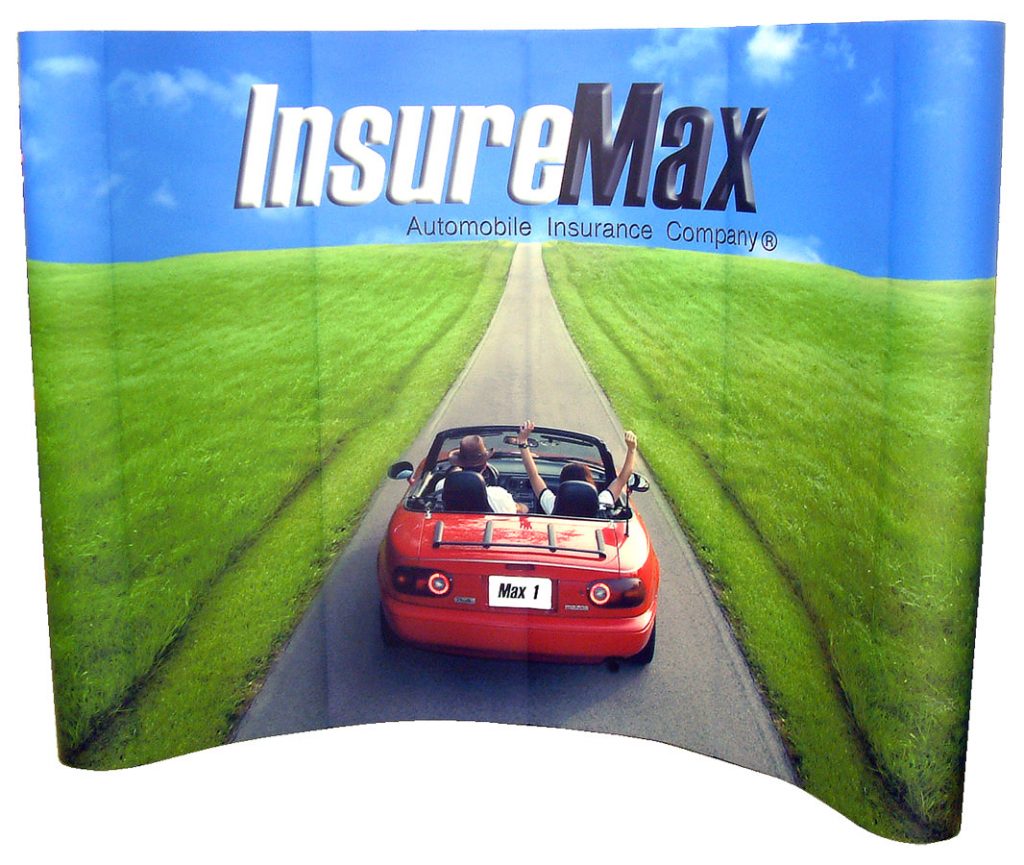
Create an environment that draws the viewer in. Let your hook leave no doubt of what you do and who you are.
Graphically, bigger is better, but you don’t have to be the biggest to be the most “disruptive.” Being “disruptive” doesn’t mean breaking the rules. It means presenting your message in a disruptive, high-impact way. Your headline, company name and brief text should be accompanied by a high-impact graphic image supporting and illustrating your product or service. Use one or more high-impact photos or rendered graphics to support your headline. This will require an experienced designer. If you do not have professional photos produced by your company you may be able to get images from an industry supplier or from a stock photo library. This is an important link in the chain of events that leads to a successful show. A source for this important graphic is your ad agency, freelance designer or the Eyekon Group.
Your headline (hook) should be followed by very brief text explaining how the UPS will be executed to benefit the prospective client. This message should tie in with your headline or “Hook”. Your text can’t tell your story and it should not. Attendees will not stand and read a lot of sales copy. This is the job of your booth staff.

This exhibitor refused to be ignored, graphically speaking. Our custom OutRigger pedestals on the left add functionality for props, literature distribution, lead and note collecting without obstructing the high-impact graphics.

Graphically, this display illustrates that sometimes less is more. Elegant graphics printed on our retractable banner stands behind our OutRigger shelf system.

Bold graphics in a 10′ space can pack a big punch!
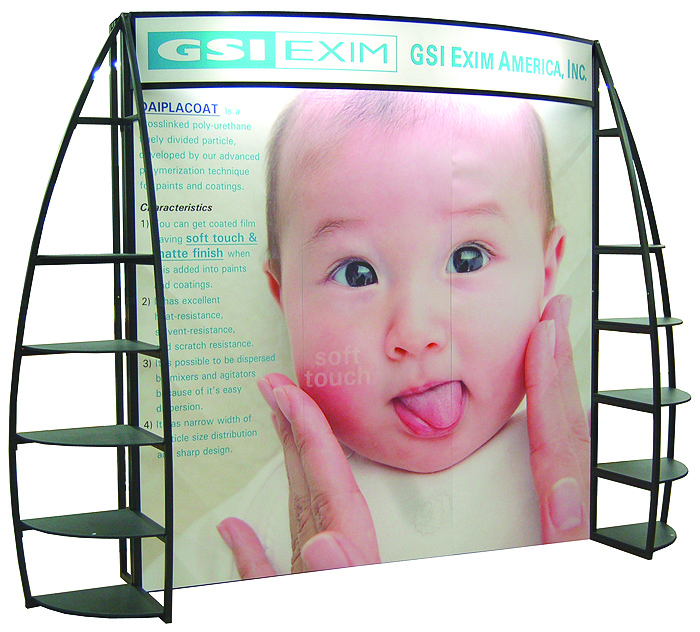
First you have to stop them before you can sell them! A simple display can have stopping power and can be functional. This display uses our OutRigger system for shelving while our retractable banner stands are the medium for the graphic message.

Bigger is better but as this display illustrates arresting graphics can have stopping power when directed at an industry-specific audience.

Strong Graphics can help make your point and invite conversation.
The value of an idea is judged by how it is presented. The value of your company is judged by how it is represented. Make sure your staff represents your company at the level to which you aspire.
Advance planning is critical. Whether you are a one-man operation or have a staff of support personnel, you need to follow a planning process, from your selling message, to display design and production to at-show strategy thru follow up. There is no substitute for pre-show meetings to develop and practice your sales message so everyone knows their role and everyone is on message. This applies to a team of two or ten booth staffers. In your planning meetings, discuss the issues, possible visitor questions and your answers and solutions. This is a good opportunity to have staffers role play to practice, develop, and feel comfortable with their own face-to-face style.
Practice your presentation (Pitch). Give the visitor the elevator pitch, i.e., describe your unique selling proposition in 30 to 60 seconds. Keep your delivery short and succinct to hold the visitor’s interest.
Make your presentation into a short conversation leading into a demonstration of your product or service, using the product, a bound presentation, your sales literature and/or your on-site computer or tablet. This presentation should begin with a comment about or discussion of industry problems followed by what you can do to solve these problems. In developing your message consider what service or benefit at which you excel. The objective is to lead the visitor into interaction that will reveal the visitors need and identify the areas in which you can provide solutions. Get Key Man contact information. If the visitor is not the “key man,” get the name(s) of other company or department managers. Again, make personal notes regarding the needs of the company.
Promise to send additional information based on the visitor’s expressed interest, or even better, request a follow-up call to his/her location for a follow-up visit.
If you have a video presentation, don’t deliver the same verbal message word for word in your conversation. But rather present a variation of your USP based on the feedback you are getting from your visitor. This interaction and feedback should be a call to action for you to provide additional information tailored to the visitor’s needs. Wait for feedback then hone in on the visitor’s specific needs. Listen to the visitor and don’t oversell by talking over the prospect.
Keep it fresh. Booth staffing is hard work and you need to keep your pitch fresh. You must always appear interested in the visitor’s needs. Practice your sales pitch. The more you practice, the more comfortable you will feel as you develop your own style.

In a casual staff atmosphere, plan your message and practice your presentation to develop your own comfortable style.
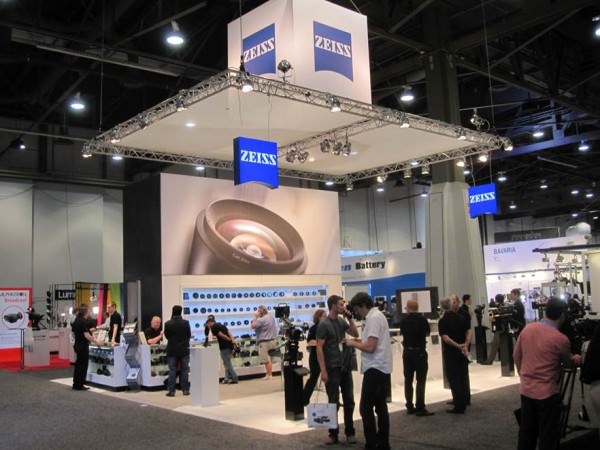
Give your visitor the elevator pitch; describe your unique selling proposition in 30 to 60 seconds.
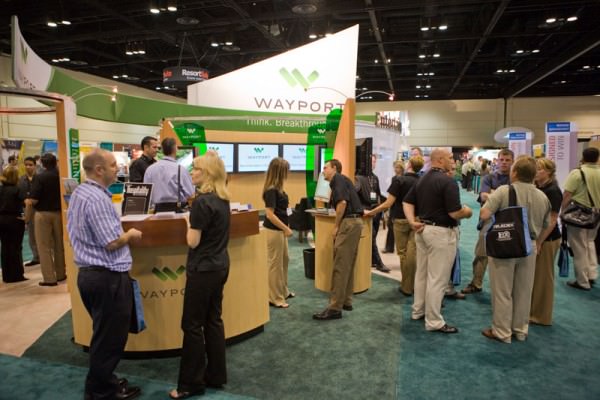
Make your USP pitch into a short conversation. If the visitor doesn’t show interest, don’t waste your time, move on to another visitor.
Before you verbally engage a visitor, make eye contact with any attendee in the aisle who looks interested in your display headline or graphics. Smile and say hello or make a general comment or friendly gesture. Do not engage attendees in the isle until the visitor indicates interest in your product or service. This is the job of your display headline and graphics. On the other hand, don’t waste your time. Once you are engaged with a visitor, qualify the visitor as a serious prospect or just an interested bystander.
Ask a non-intrusive question. For example “how are you finding the show?” or “Have you found the show helpful?” Then be more specific with “What does (company on name-tag) do?” “May I help you?” is a little too general. “If the visitor expresses interest you might ask if you may provide information on a specific aspect of your industry, product or service but, each booth staffer will need to develop his or her own style. These innocuous questions help relax the visitor while providing you with lead qualifying information as to the “quality” of the visitor. Give the visitor a chance to interact and provide more specific information. If you determine the visitor is not a serious prospect, then politely suggest the visitor have a nice day or enjoy the show, then move to a different spot in your booth space.
Again, never intercept a visitor by impeding his or her path in the aisle. Ask your questions of the visitor if he or she shows interest in your headline or video hook. Ask questions to identify the special needs and interests of the visitor. This will be your invitation to suggest how your product/service can meet the visitor’s needs and solve problems. Engage visitors with friendly body language and a relaxed disposition. Don’t be aggressive or sound desperate, relax and enjoy yourself. Get and use the visitors name up front and use it going forward in your conversation.
At this point you can provide more technical information or call over a technical staffer from your company. If there is information you can’t provide at the show, make a note and promise the visitor a follow-up via email, phone call. If you don’t have a technical staffer at the show, get the information from your technical specialist in the home office or from the tech department of your vendor and deliver the answer to the visitor by the end of the day or the next day. This will keep you fresh in the mind of the visitor and help develop a more receptive attitude with the prospect. This follow-up exchange would be a good time to set an appointment with the prospect for a visit to his or her home office.
If your exhibit space permits, you may want a technical authority from the home office to answer questions from visitors who want to get a little deeper in the weeds with regard to the technical aspects of your service or product. If space is limited you could have a connection directly from your booth space to your company via Skype to interact with visitors and fill in details your booth visitor may require.

Do not engage visitors in the isle until the visitor indicates interest in your product. This is the job of your “hook” headline and your graphics, or demo piece.

Ask questions to identify the special needs of your visitor. This will be your invitation to suggest how your product can meet the visitor’s needs.

Stay Fresh. Booth staffing is long, hard work.
You will need a badge scanner, or at a minimum, have a fill-in form to capture visitor information. If necessary prepare and customize this form before you depart for the show. A pre-show planning meeting is a good time to design this form. You will want to develop a routing and tracking process – either computerized, or at least, a ledger to track your leads. If available from show management, take advantage of the shows lead capture system. Collect business cards and make personalized notes on your personal data form. To capture sales you must capture good data that further qualifies the prospect to make sure the sales team gets the complete profile in order to make the most of their sales time pursuing “good” leads. Always execute a lead follow-up report that ensures deadlines are met. An office administrator would be helpful in maintaining this report.
Get leads to field sales or home office staff immediately. If possible, email them daily for sales people to start prepping follow-up literature and custom messaging to be delivered to prospects collected at the show. Make sure leads contain sufficient information, i.e., contact name, position, specific interest expressed by the prospect. Develop solutions to be delivered by your sales team.
As part of the follow-up process after the show, you or your office staff can follow up immediately via email to acknowledge prospects visit to your booth. Email can be personalized with a reference to the prospect’s in-booth comments. This would be the beginning of a line of communications between you and the prospect. If you plan to send product literature or a letter / sale sheet, do so immediately to keep your company fresh in the mind of the prospect. A follow-up phone call should be made within a week of your follow-up contact. This process should be documented along with assigned dates on your pre-show and post-show schedule.
Learn from your show experience. Do a self-analysis of your show performance and create a results report.
Note: Your ROI might not be immediate, which is why your leads must be followed up immediately and over a several months.

Before departing for the show, plan and arrange your method of collecting leads at the show.

Fresh leads are like fresh fish, they can become stale after a few days. A prospect can lose interest and decide on another vendor from the show who followed up promptly.

While it is fresh in your mind, make notes of your experiences and impressions from the show. Post-show analysis of your results and the data you gather can be helpful information for the next show.
Logistics is more than reserving your show space, making travel plans, and scheduling delivery of your display property to the show. “Getting you there” means connecting all the links that make up the chain of events leading to a successful exhibit marketing campaign. “Getting you there” means successfully executing an integrated program that gives you the best chance for success and a good ROI.
Things to consider: The experience of your carrier in trade show deliveries. Timing for the arrival of your display at the show. If you are not delivering your display yourself, you need to determine if you want your display delivered to the official trade show service warehouse or to an independent contractor, or directly to the show. If to the show, get a time frame from the show management for the best time to schedule your carrier’s arrival in order to avoid chargeable dead time in the marshaling yard which is adjacent to the trade show venue. This information could be part of the services ordering process prior to the date of the show, preferably, a good length of time before the show. Last minute decisions are expensive.
For Portable Displays
Actually getting to the show requires some advance planning and is an aspect that should be considered when planning the size of your display and the display case or crate. Many portable displays are compact enough to travel to the show with you. Obviously, if you drive to the show you can carry exhibit material in your vehicle, but an SUV or van is recommended because even the most portable display will crowd a standard size auto. If you are flying, many portables are small enough to travel with you as excess baggage. Check with your carrier well in advance. UPS and FedEx are dependable carriers but you will need to ship to a dependable reception partner on the other end of the shipment. Most large hotels will receive your UPS or FedEx shipment and hold it at your hotel.
UPS and FedEx limit your shipping weight to a total of not more than 150 lbs. Size is limited to 165″ in girth (inches around shipping case) plus length of shipping case. For example, a display case that measures 116″ around, plus 48 inches long would be a total of 164 inches, therefore, would ship within the standards of UPS and FedEx, assuming the case weighs less than 150 lbs. These specifications are subject to change so you should check with your local shipping office.
Often portables are combined to form a larger display. If you have multiple portable cases or a portable case is just over the limit of FedEx, we recommend that multiple portable units not be shipped in separate shipping cases, but instead, they should be combined into a single crate and treated as if it were a custom display, and shipped via common carrier truck line, i.e., if your personal vehicle is not large enough to accommodate the case or the distance to the show makes it impractical for you to drive.

Connecting your company with the floor show is a critical link to successful trade show marketing. Make sure you select the best logistical options.

Consider the unique nature of your display and its’ shipping to make sure you select an experienced carrier; i.e., is your display or your company exhibit materials susceptible to humidity, shaking, heat or cold. Deal with an experienced carrier and advise him of any potential issue that requires special handling. This is critical if you are shipping custom exhibit materials.

Fed-Ex and UPS are the primary carriers of small event displays and are very dependable. (Side note: This Fed-Ex truck prop, which we produced using our proprietary fabric architecture, illustrates the practical application of fabric construction. For more information see our Best-of-the Best display products section of this website).
The restrictions on custom crates are more nebulous and less restrictive but, because your investment is much greater in a fully custom display, important considerations need to be made in advance. Generally for custom displays, your shipping crates will be planned after your design is fabricated. Larger display components may need to break down for shipping, to be assembled at the show. Most displays ship in crates in the 4’x4’x8′ range, but since the crates will be shipped by trailer truck or van line the crates can usually be large enough to accommodate large display components. This is a consideration because the more complete your display can be, the less assembly will be required at the show and the less time and labor will be required.
Although there are fewer restrictions on crate size, you should make sure that the crates (or equipment pallets) will fit thru the doors of the show venue. Your destination might also require that your delivery vehicle have a rear lift gate to unload if the venue doesn’t have a dock. These considerations do not come into play if you are shipping to a major show venue or the show’s pre-show warehouse. These things can be determined with a call to the venue management.
Note: The above considerations are why fabric architecture has become a major trend, i.e., less
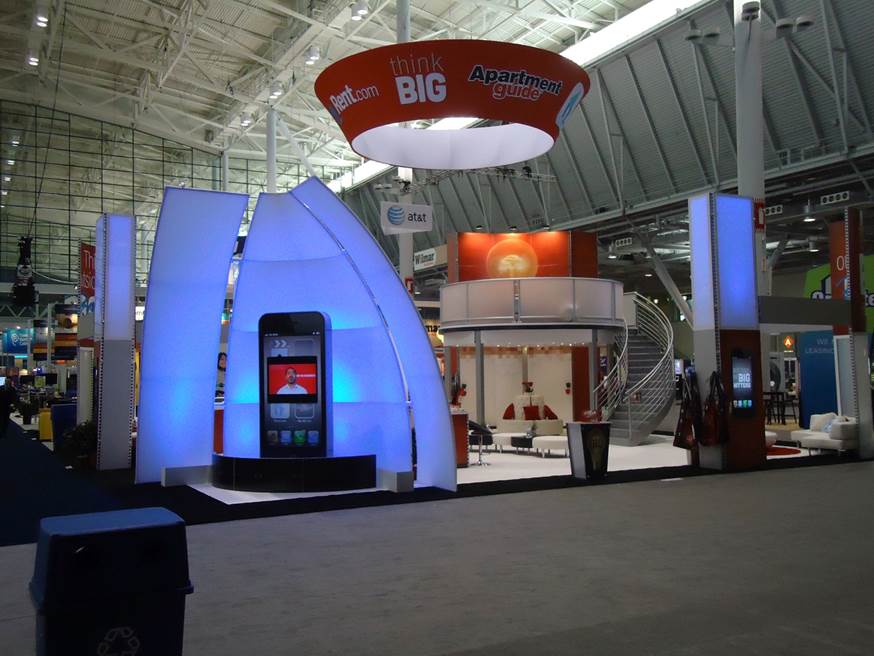 Specifying lightweight materials that are less subject to damage is a good tactic because it not only simplifies packing and shipping, but it also reduces costs. But, regardless of materials, make sure you advise the carrier if your exhibit property requires special handling, which may dictate special packaging.
Specifying lightweight materials that are less subject to damage is a good tactic because it not only simplifies packing and shipping, but it also reduces costs. But, regardless of materials, make sure you advise the carrier if your exhibit property requires special handling, which may dictate special packaging.

“Hard wall” displays have also become more economical for shipping as well with the advent of extruded, modular aluminum frames which can be reused and which have reduced shipping costs compared to wood and laminate construction of yesterday. Fabric graphics may be combined with modular frames for even greater savings in production and shipping.

Large Format Fabric Architecture makes Big Displays practical and has significantly reduced shipping and setup costs. Large images and shapes not possible until recently has become a major trend.
While trade show marketing has become more cost effective, business managers have less time to devote to this singular event. As important as your trade show marketing is to your bottom line, unless you’re a large integrated company, you probably can’t afford to give up valuable time to planning & executing a single event while executing your day to day management responsibilities, yet, you can’t afford to go it alone, unprepared for a successful return on your investment.
The Eyekon Group goes beyond the services of the normal exhibit house to provide a turn-key resource for successful trade show and experiential marketing execution. The Eyekon Group is rooted in the advertising agency business before morphing into a trade show marketing company more than 30 years ago. We literally wrote the book on display ideas. As pioneers in contemporary trade show marketing, we have designed, engineered, developed, patented and produced many innovations in portable and custom exhibit applications, including a recent, award-winning, eco-friendly modular display system for sustainable marketing practices. Think of us as your ad agency with years of exhibit marketing experience. We have many “Best of Show” awards to demonstrate our innovative approach.
We have worked with CEOs, CFOs, tradeshow managers and ad agencies, helping them avoid many of the pitfalls and minefields in trade show marketing. Our recommendations are based on our many years of experience in developing and integrating media technologies and construction methods. We have experience in selecting the most effective delivery technique to best present your message. We bring to your exhibit project specialists who fit the technical level & sophistication of your specific project. We draw from our years of experience and the many resources developed along the way.
Our group will take your project from any stage. After reviewing our 30-Minute primer on best trade show practices, go to our Best-of-the-Best presentation products section of this web site. Compare our free design and product recommendations for your display hardware and graphics so that you can move with confidence to manage your campaign. Or, you can engage the Eyekon Group to complete the process of message development, fabrication, graphics production and delivery. We can supply one link in the chain or we can supply the complete chain.

The Crash Course author literally wrote the book on display design ideas. And has been engaged in the advertising and trade show industry for more than 30 years. He has managed exhibit marketing programs and authored numerous “Ideas On Display” promotional guides to display design, production and graphics.

H. Glenn Godfrey, CEO, Eyekon Group, wrote numerous books and articles for “Ideas on display.”
The Eyekon Group has its roots in the advertising agency business before morphing into a trade show display company based on the needs of agency clients.
Contact us to schedule a consultation with a trade show expert or browse our products

